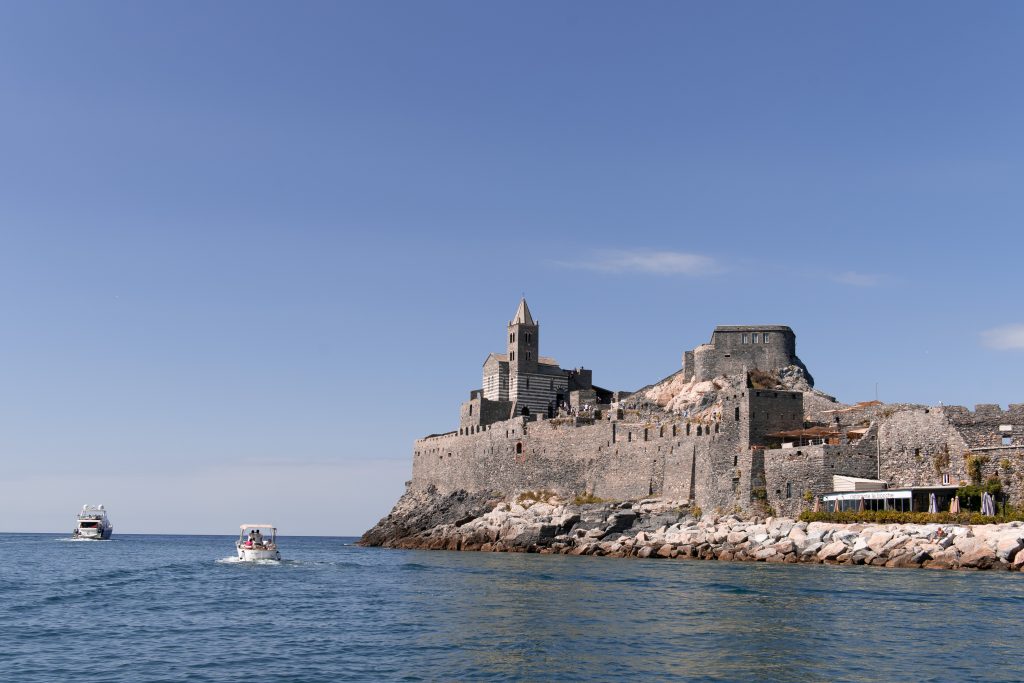
PORTOVENERE
...here in the hills covered by the olive tree it is said that even Minerva forgot her homeland Athens for such sweetness...
This is how Petrarch described Portovenere, the ancient Veneris Portus, so called because of the temple of Venere Ericina, that stood where today we can find church of Saint Peter, which seems to arise from the rocks overlooking the sea.
Perched on the west extremity of the Gulf, Porto Venere strikes us with its Genoa style houses, a sort of colored tower-house complex, built to create a defensive bulwark.
Surrounded by a crystal clear sea, background to three green islands: Palmaria, Tino and Tinetto.
On the 17th of August there is the Madonna Bianca festival, celebrating the end of the 1399 plague with a procession and thousands of candles lighting all the village.
In front of the Olivo, in Portovenere Canal, we can see the mussel farming poles, an ancient tradition already practiced by the Romans.
PORTO VENERE
This is how Petrarch described Portovenere, the ancient Veneris Portus, so called because of the temple of Venere Ericina, that stood where today we can find church of Saint Peter, which seems to arise from the rocks overlooking the sea.
Perched on the west extremity of the Gulf, Porto Venere strikes us with its Genoa style houses, a sort of colored tower-house complex, built to create a defensive bulwark.
Surrounded by a crystal clear sea, background to three green islands: Palmaria, Tino and Tinetto.
On the 17th of August there is the Madonna Bianca festival, celebrating the end of the 1399 plague with a procession and thousands of candles lighting all the village.
In front of the Olivo, in Portovenere Canal, we can see the mussel farming poles, an ancient tradition already practiced by the Romans.

PALMARIA
A natural Paradise, it is the biggest island of the Ligurian Archipelago, it is part of the UNESCO World Heritage sites, as well as Portovenere, Cinque Terre, Tino and Tinetto.
Raggiungibile con mezz’ora di traghetto dalla Spezia, attira sia gli amanti del mare limpido e pulito che gli escursionisti, che possono fare il giro completo dell’isola in meno di una giornata, percorrendo sentieri che si snodano tra la vegetazione, accanto a vecchie fortificazioni militari, quale il forte Umberto I, detto la Fortezza del Mare e che oggi ospita convegni e eventi.
There are two main beaches: Punta Secco, in front of Porto Venere in the stretch of water known as Le Bocche, and Il Pozzale, di fronte al Tino.
Alla Palmaria si trova la spettacolare Grotta Azzurra, the 'Azure Cave', named after the water color, so narrow that only small boats can enter it.
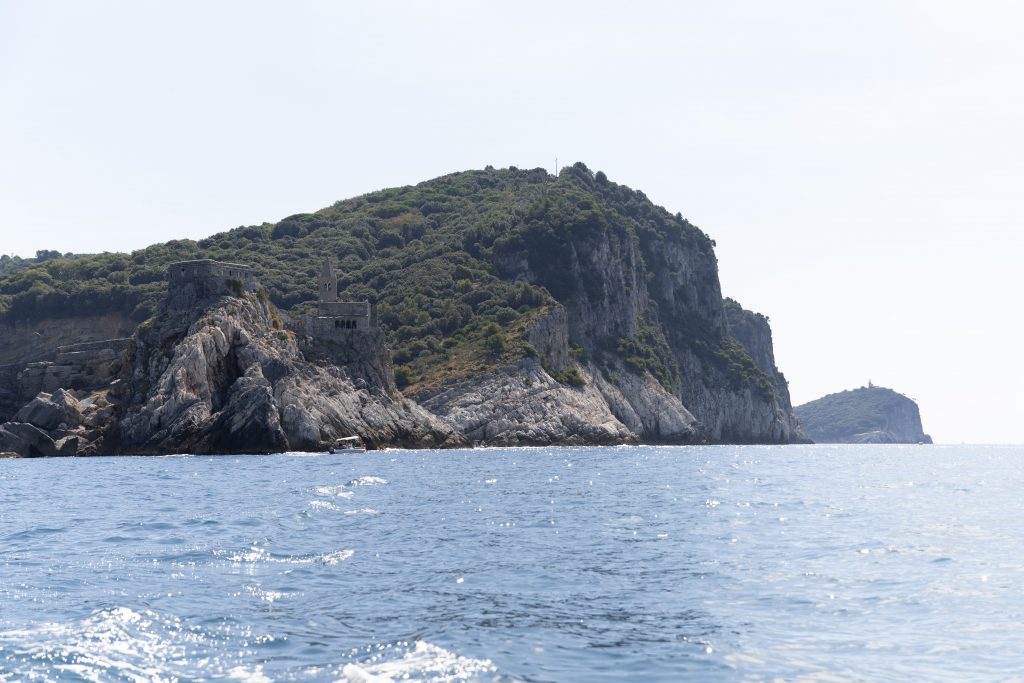

PALMARIA
A natural Paradise, it is the biggest island of the Ligurian Archipelago, it is part of the UNESCO World Heritage sites, as well as Portovenere, Cinque Terre, Tino and Tinetto.
Raggiungibile con mezz’ora di traghetto dalla Spezia, attira sia gli amanti del mare limpido e pulito che gli escursionisti, che possono fare il giro completo dell’isola in meno di una giornata, percorrendo sentieri che si snodano tra la vegetazione, accanto a vecchie fortificazioni militari, quale il forte Umberto I, detto la Fortezza del Mare e che oggi ospita convegni e eventi.
There are two main beaches: Punta Secco, in front of Porto Venere in the stretch of water known as Le Bocche, and Il Pozzale, di fronte al Tino.
Alla Palmaria si trova la spettacolare Grotta Azzurra, the 'Azure Cave', named after the water color, so narrow that only small boats can enter it.
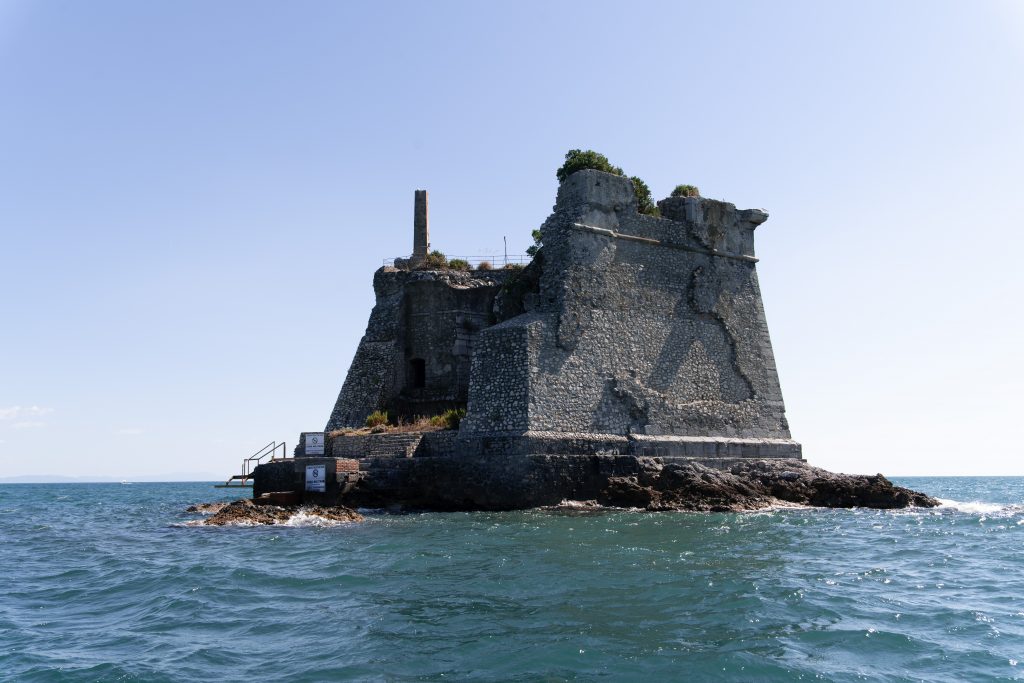
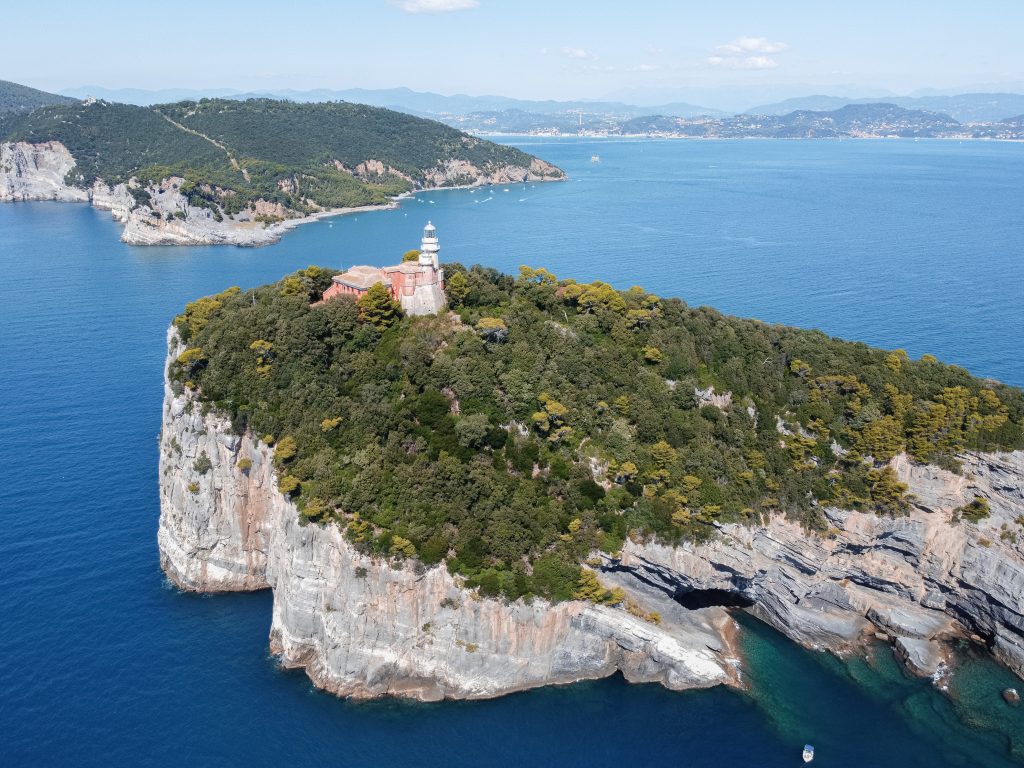
TINO
San Venerio, the Gulf of La Spezia patron, lived here as a hermit until his death in 630. A Benedictine monastery was erected upon his tomb and inthe 1435 it was occupied by the Olivetans, who then had to leave to flee the Saracens. It was in the waters in front of the Tino that the Republic of Genoa defeated the Pisan fleet in the Battle of Giglio in 1242.
Nowadays the island is military territory and access is prohibited to everybody, except on San Venerio festival. On September 13th the Saint's statue is brought in procession from La Spezia to Tino by sea, both on the same day and on the following Sunday. It is truly spectacular to join the multitude of boats of all sizes that follow the Saint as dusk falls and the blessing is given at sea, while the lighthouse stands on the island, which with its lantern located 117 meters above sea level is one one of the most important in the Tyrrhenian Sea and celebrates San Venerio who, by lighting fires, helped sailors to orient themselves among the dangers of the sea.
TINO
History
San Venerio, the Gulf of La Spezia patron, lived here as a hermit until his death in 630. A Benedictine monastery was erected upon his tomb and inthe 1435 it was occupied by the Olivetans, who then had to leave to flee the Saracens. It was in the waters in front of the Tino that the Republic of Genoa defeated the Pisan fleet in the Battle of Giglio in 1242.
Today
Nowadays the island is military territory and access is prohibited to everybody, except on San Venerio festival. On September 13th the Saint's statue is brought in procession from La Spezia to Tino by sea, both on the same day and on the following Sunday. It is truly spectacular to join the multitude of boats of all sizes that follow the Saint as dusk falls and the blessing is given at sea, while the lighthouse stands on the island, which with its lantern located 117 meters above sea level is one one of the most important in the Tyrrhenian Sea and celebrates San Venerio who, by lighting fires, helped sailors to orient themselves among the dangers of the sea.

GROTTA BYRON
We can find Grotta Byronin the Porto Venere Natural Park, between the castle walls and San Pietro Church. It is a natural cavity deep twenty meters, appreciated by both amateurs and pro scuba divers, as it is a simple dive and you can find a plethora of different species. This rich biodiversity also attracts bio marine experts, who take lectures and meetings at the cave.
Small fish find refuge in the stinging sea anemones tentacles, along crustaceans, nudibranchs and shrimps.
The cave, originally known as Grotta Arpaia, owes its name to the ' cursed poet ', who is said to have found inspiration here for his poem The Corsair . If this wasn't enough it also seems that Byron, a skilled swimmer, started from this cave for an eight km swim to reach his friend Shelley in San Terenzo. This is why the Byron Cupis held every year, a swim race retracing Byron's itinerary, and every year this event attracts many participants.
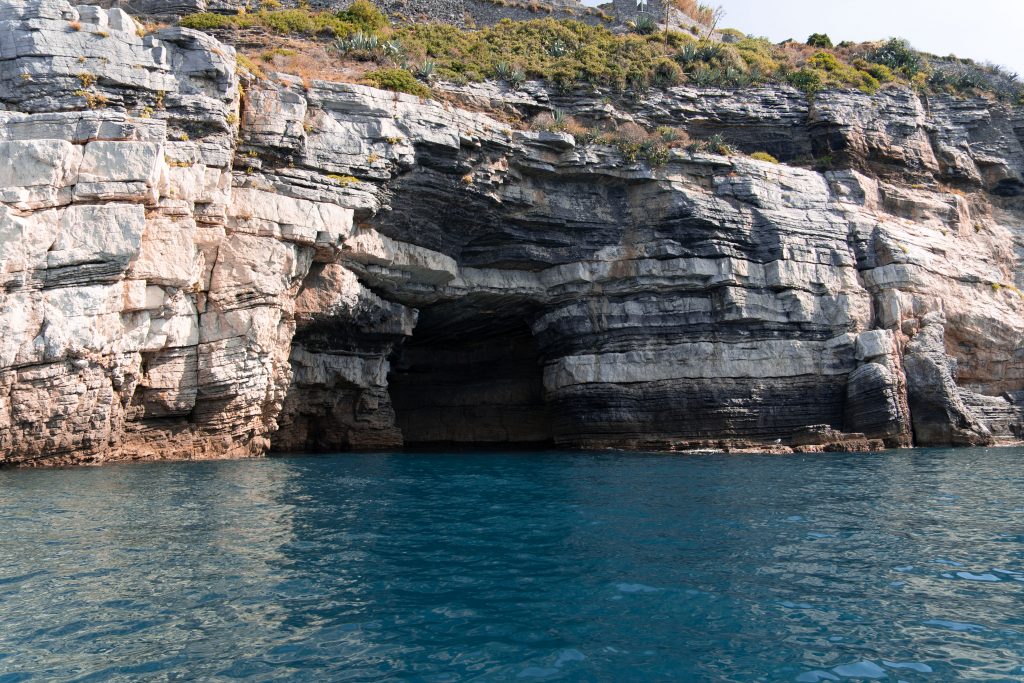
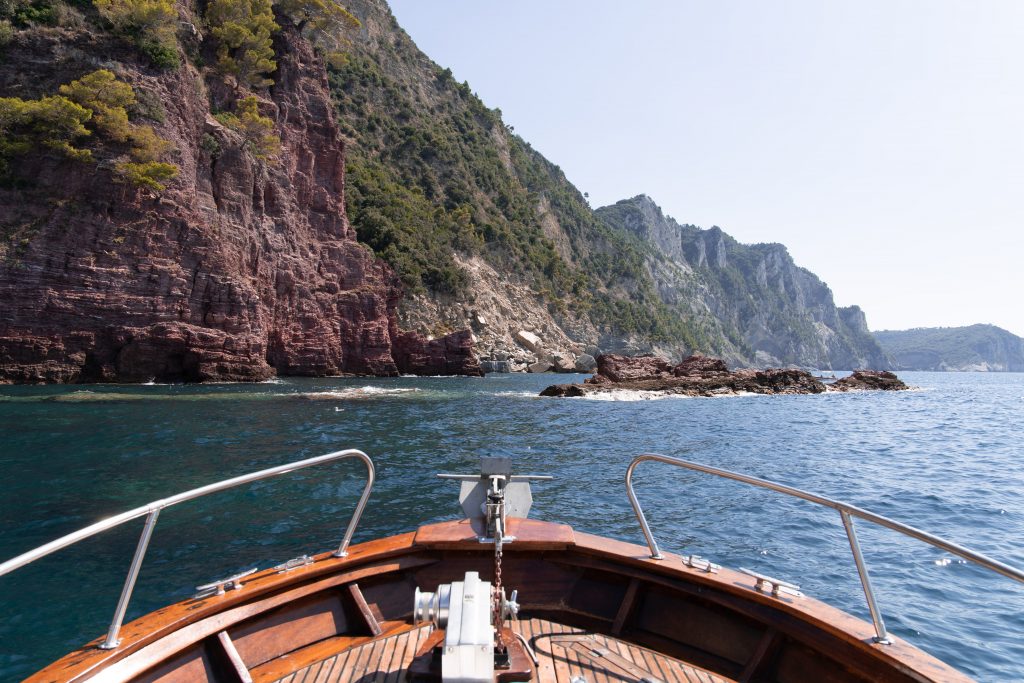
LE ROSSE
If you go to Cinque Terre from Portovenere by boat you will be amazed by an enchanting beach surrounded by wine-red rocks. This is 'Le Rosse' actually called Albana beach, one of the Tramonti spots. This peculiar color is due to a high concentration of fossil ammonite in the rocks. The chromatic anomaly is even more fascinating given that the rest of the coast is white but for another trait of black rocks: 'Le Nere'.
This is probably the best spot to enjoy the sea, both for the incredible clarity of the water and the red reflections of the rocks, as well for the exclusivity of this beach. In fact you can only reach this beach from the sea, as the path from Campiglia is extremely dangerous.
Reaching it by boat and a little swim con offer an unforgettable experience.

le rosse
If you go to Cinque Terre from Portovenere by boat you will be amazed by an enchanting beach surrounded by wine-red rocks. This is 'Le Rosse' actually called Albana beach, one of the Tramonti spots. This peculiar color is due to a high concentration of fossil ammonite in the rocks. The chromatic anomaly is even more fascinating given that the rest of the coast is white but for another trait of black rocks: 'Le Nere'.
This is probably the best spot to enjoy the sea, both for the incredible clarity of the water and the red reflections of the rocks, as well for the exclusivity of this beach. In fact you can only reach this beach from the sea, as the path from Campiglia is extremely dangerous.
Reaching it by boat and a little swim con offer an unforgettable experience.
Grotta Byron
We can find Grotta Byronin the Porto Venere Natural Park, between the castle walls and San Pietro Church. It is a natural cavity deep twenty meters, appreciated by both amateurs and pro scuba divers, as it is a simple dive and you can find a plethora of different species. This rich biodiversity also attracts bio marine experts, who take lectures and meetings at the cave.
Small fish find refuge in the stinging sea anemones tentacles, along crustaceans, nudibranchs and shrimps.
The cave, originally known as Grotta Arpaia, owes its name to the ' cursed poet ', who is said to have found inspiration here for his poem The Corsair . If this wasn't enough it also seems that Byron, a skilled swimmer, started from this cave for an eight km swim to reach his friend Shelley in San Terenzo. This is why the Byron Cupis held every year, a swim race retracing Byron's itinerary, and every year this event attracts many participants.

GROTTE DELLA PALMARIA
The Island of Palmaria owes its name to its caves, originally known as Balme, from this Balmaria and finally Palmaria. The most famous of these caves are Grotta Azzurra, Grotta dei Colombi and Grotta Vulcanica.
Grotta Azzurra is only reachable from the sea, it is sixty meters long and twenty deep and the colours found here are amazing.
Grotta Vulcanica (Volcanic Cave), by Cala Grande, reminds of a solidified lava river.
Grotta dei Colombi is another matter: at 30 meters above sea level it was explored in the 1800s and it was inhabited in the Paleolitic and Neolitic eras. In fact several artifacts from these periods have been found inside the cave, like arrowheads, scrapers, perforated seashells and human and animal remains. Historians believe that Grotta dei Colombi could have been both a settlement and burial place.
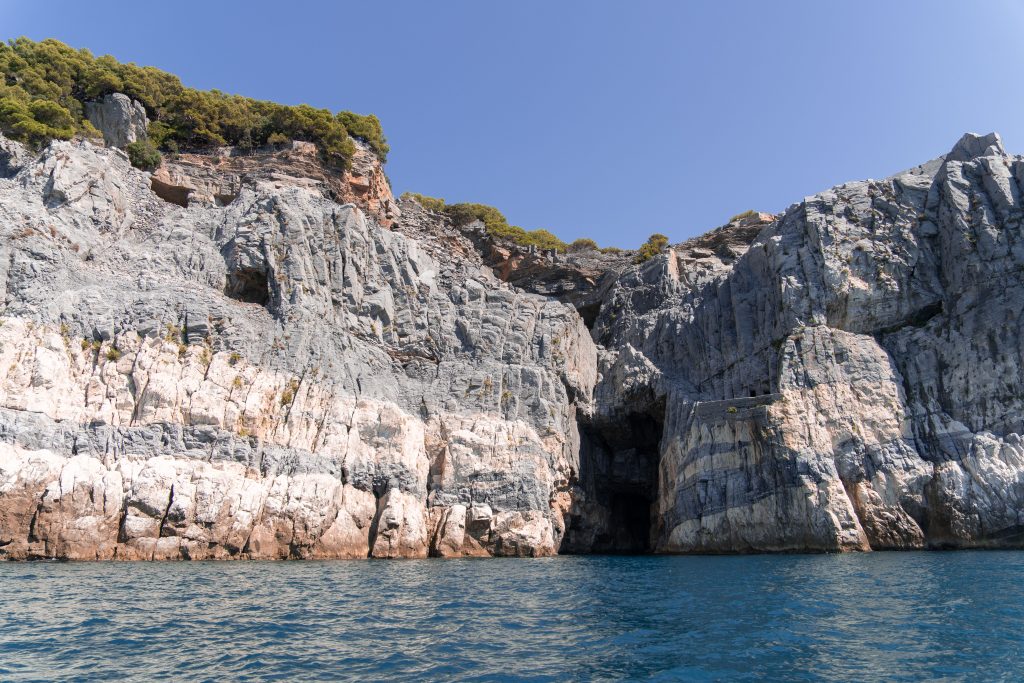

Grotte della Palmaria
The Island of Palmaria owes its name to its caves, originally known as Balme, from this Balmaria and finally Palmaria. The most famous of these caves are Grotta Azzurra, Grotta dei Colombi and Grotta Vulcanica.
Grotta Azzurra is only reachable from the sea, it is sixty meters long and twenty deep and the colours found here are amazing.
Grotta Vulcanica (Volcanic Cave), by Cala Grande, reminds of a solidified lava river.
Grotta dei Colombi is another matter: at 30 meters above sea level it was explored in the 1800s and it was inhabited in the Paleolitic and Neolitic eras. In fact several artifacts from these periods have been found inside the cave, like arrowheads, scrapers, perforated seashells and human and animal remains. Historians believe that Grotta dei Colombi could have been both a settlement and burial place.

